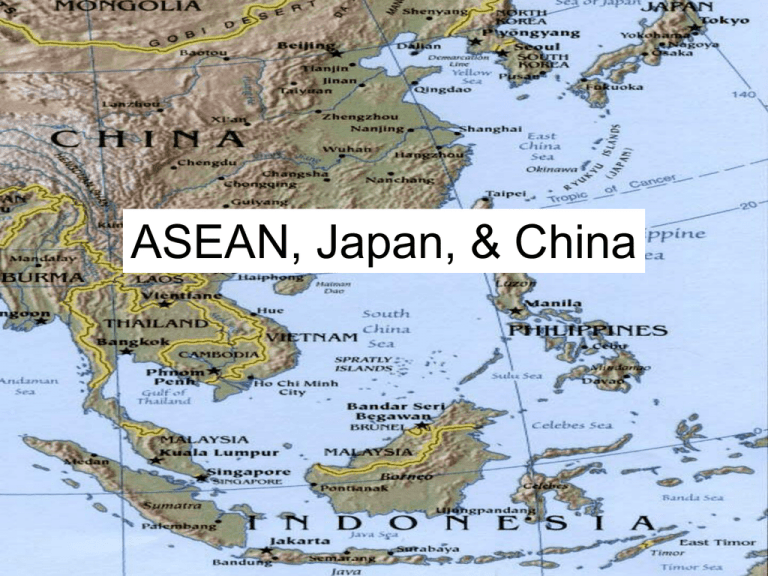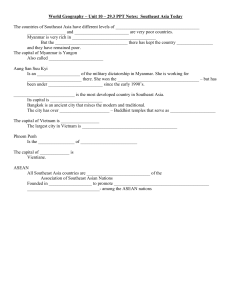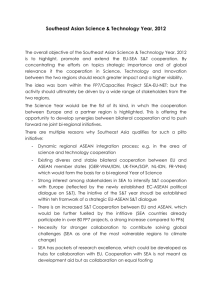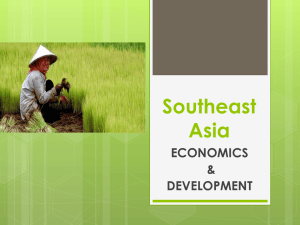ASEAN, Japan, & China
advertisement

ASEAN, Japan, & China Historical legacy (1942 - 1945) • Japan occupied the whole Southeast Asia Japan’s Appeal in WWII • Japan’s appeal to Southeast Asia during World War II – Economic benefits • Japanese model for economic development since the Meiji Restoration of 1868 • ``Greater East Asia Co-Prosperity Sphere” – Anti-colonialism • ``Asia for the Asians” • nationalist movements ``Co-Prosperity Sphere” • ``Greater East Asia Co-Prosperity Sphere” • Japan’s economic foreign policy During World War II • Absorption of the economies of all occupied countries • Extraction of resources to fuel the war against the Allies Consequence of WWII • How did Southeast Asia change? – Decline of Western colonial power – Decline of the myth of European superiority – Rise in • Southeast Asian independence movements • Japanese interests and influence in Southeast Asia • US interests and influence in Southeast Asia – Integration into global economy & community Japan Returns (1950s) • US strategy concerning Japan – ``dynamo of wider regional recovery in Free Asia” – contain Communism • Closure of China market to Japan in 1950s and 1960s – Japan’s economic dependence on US – materials and markets of Southeast Asia Japan & Southeast Asia: 1 • Japan’s economic diplomacy in ASEAN – bilateral trade promotion & economic linkage • >1/4 of ASEAN’s total trade was with Japan • Japan invest more in ASEAN than US – Asian Development Bank (established in 1966) – avoid taking any political initiative • 1974: anti-Japanese demonstrations during Japanese Prime Minister’s visit ASEAN Attitudes • Singapore Prime Minister Lee Kuan Yew said in 1969: – ``My generation and that of my elders cannot forget [WWII] as long as we live” – ``The policy of our government is not to allow the unhappy experiences of the past to inhibit us from a policy which can enhance our growth rates by Japanese participation” P.R.C. and ASEAN: 1 • In 1960s, Mao supported communist insurgencies in Southeast Asia – PRC-ASEAN relations were damaged by Mao’s policies during Cultural Revolution • changes in 1970s – PRC domestic policies became less radical – U.S. President Nixon visited Beijing and Shanghai Japan & Southeast Asia: 2 • Anti-Japanese demonstrations of 1974 • Fall of South Vietnam in 1975 • Japan began taking an active interest in the political affairs of Southeast Asia – from bilateral relations to focus on ASEAN Japan’s Reaction to 1978 • 1978: Vietnam invaded Cambodia – threatened Japan’s economic interests – Japan maintained a dialogue with Vietnam • Japan’s reaction – aligned with US-ASEAN-PRC camp – halted economic assistance to Vietnam – called for Vietnam to withdrew all troops from Cambodia P.R.C. and ASEAN: 2 • US relationship with PRC normalized in 1979 – US-PRC alignment in opposing the spread of Soviet influence in Southeast Asia – ASEAN-PRC alignment in opposing Vietnam • PRC started reform and opening in 1979 – trade and economic ties with ASEAN gained importance ASEAN’s Attitude to Japan • Distrust remained but reduced • Fears of Japan’s imperialist tendencies remained but reduced ASEAN-Japan Econ. Links • Economic links strengthened – ASEAN countries’ development programs needed Japan’s support and investment • Japan as an economic model and partner – Malaysia’s ``Look East” – Laos and Singapore’s ``Learn from Japan” • Complementary economies of Southeast Asia and Japan Japan & Southeast Asia: 3 • Since the end of the Cold War • Japan redefined its role in international affairs after the Cold War • Japan-ASEAN relationship strengthened – greater interactions • ASEAN as a region and as an institution – Japan’s deeper involvement in regional affairs • more politically engaged Japan’s Political Role • 1990: Tokyo Conference on Cambodia • 1992: Japan sent 1,800 troops as UN peacekeeping forces to Cambodia • since 1994: active participant in regional multilateral arrangements such as ASEAN Regional Forum (ARF) • since 1997: political/security dialogues with Singapore, Thailand, and Indonesia ASEAN Receptiveness • Malaysia Prime Minister Mahathir said in 1991: – ``As we approach the year 2000, it is our hope that Japan will initiate changes in its policies that will effectively bring about an enhanced political, socio-cultural role in not only the Southeast Asia region but also in the global context” Diminishing Role of History • After the Cold War • Increasing economic interdependence between Japan & Southeast Asia • Fear of Japanese remilitarization reduced • Generation change • “China threat” Rise of China • China’s ``Reform & Opening-up” policy • Increasing presence in Southeast Asia – Expanding trade – Political relations and influence • visits by leaders and summit meetings • substantive agreements on issues ranging from trade to military cooperation • by 1991 PRC has normalized relations with all the ASEAN member states Growing Regionalism (A+3) • 1995: Asia-Europe Meeting in Bangkok – ASEAN asked Japan, China, & South Korea to join as Asian representatives – Japan feared alienating US & China • US & Australian reservations about a regional grouping in Pacific Asia – impact on the success of APEC – possible division of global economy ASEAN+3 Summit • China & Japan compete for regional leadership position • ASEAN+3 summit has taken place at each of the ASEAN summit since 1997 • regular ASEAN+3 meetings of finance & economic ministers Asian Financial Crisis (‘97) • Japan’s role in Southeast Asia – contribution of funds and initiatives • emergency financial assistance • aid plan for regional human resource development • cooperation in information technology sector – inaction on banking reforms – ineffective economic stimulus measures • ASEAN urged faster action to help recovery Asian Financial Crisis (‘97) • • • • • • China’s role: refrained from devaluing yuan contribution of funds and initiatives entry into World Trade Organization (2001) ASEAN-PRC Free Trade Area (2001) threatens Japan’s economic leadership in Southeast Asia Japan • Japan signed its first-ever free-trade agreement (with Singapore) in 2002 • Economic Partnership Agreements (EPA) ASEAN Free-Trade Agreements • • • • • • ASEAN-Australia-New Zealand FTA ASEAN-China FTA ASEAN-India FTA ASEAN-Japan FTA ASEAN-Korea FTA ASEAN and its FTA partners negotiations for the Regional Comprehensive Economic Partnership (RCEP) Conclusions • ASEAN+3 have considerable potential – APEC may be too broad – ASEAN may be too narrow • Contested regional leadership position between Japan and China • Japan: the most advanced economy in Asia • China’s momentum








